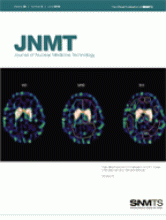Abstract
The accumulation of technetium by plants has been widely studied and reported in the literature from the perspective of the incorporation of environmental 99Tc into the food chain. Pertechnetate (TcO4−) is the most stable surface chemical form of technetium and is known to be extracted by plant roots, transported by the xylem, and reduced in the leaves; however, the mechanism of action is not entirely clear. Measuring the distribution of technetium in plants has been challenging, many questions remaining unanswered. To date, tracer studies for plant physiology (radionuclide and color dye) have relied on destructive sampling, prohibiting repeat-design experimentation. This article explores the technical issues relating to the application of scintigraphic imaging to plant physiology. The benefits and limitations of methods for introducing radiotracers to plants are outlined. Strategies for the successful labeling of various plant organs with 99mTc and several unanticipated artifacts are described. The relevance of these labeling experiments to the study of plant vascular transport is explained, and strategies for optimizing the scintigraphic imaging of plants are outlined. Assessing plant physiology is an emerging frontier, especially given the growing importance of water management and the increased competing demand for crops as biofuels.







